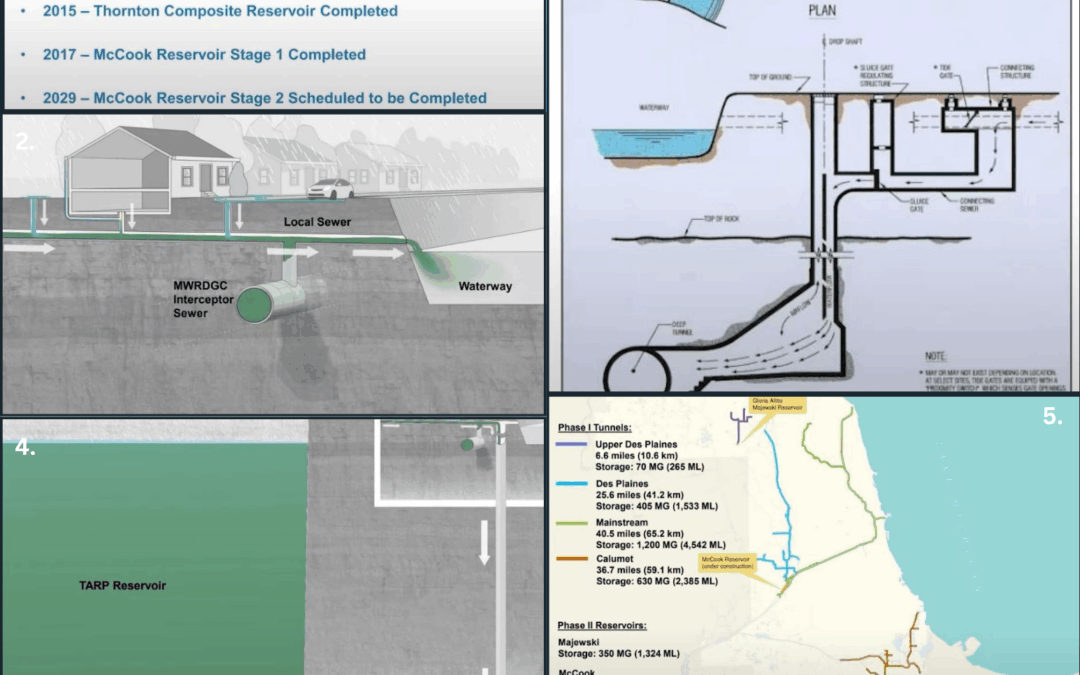Building Futures (BF) is about identifying projects, ideas, and innovations that create lasting positive change within the building community and the communities it serves.
Throughout my professional career, most building projects have relied on the assumption that a functioning “grid” of power, water, sewer, telecommunications, transportation, and internet systems was readily available. Yet, for far too long, these essential networks have been neglected, undermaintained, and rarely replaced when they’ve exceeded their design life. Driving through Chicago in recent years has been both frustrating—because of congestion—and exciting, as major infrastructure renewal is finally visible across highways, rail lines, bridges, and data centers.
This BF reviews the purpose and construction of Chicago’s Deep Tunnel and Reservoir Plan—an infrastructure system decades in the making that has significantly reduced flooding across the metro area.
We are now in the early stages of reimagining and rebuilding the core systems that support how we live, work, and move through our cities. Building Futures will continue to explore this vital infrastructure, beginning with the foundational systems—like TARP—that make modern urban life possible.
The Tunnel and Reservoir Plan (TARP) was conceived to address chronic flooding throughout the Chicago area. I first became aware of it as a high school student, passing by the massive tunnel construction sites along McCormick Boulevard in Skokie. At the time, I only understood it conceptually. Shafts being built for ventilation and access, but later came to appreciate the extraordinary engineering behind it.
Historically, Chicago operated a combined sewer and storm system (CSSS), where wastewater from homes and storm runoff flowed together through the same pipes and discharged directly into nearby waterways such as the Chicago River and Lake Michigan. In the 20th century, the Metropolitan Water Reclamation District (MWRD) built interceptor sewers to capture and redirect this flow to treatment plants (now totaling seven across the region). However, as population density increased and storms intensified, the system became overwhelmed—flooding basements, streets, and neighborhoods. To prevent further damage, the MWRD often had to release untreated sewage directly into local rivers and the lake, something that occurred more than 100 days per year in the 1960s.
Planning for TARP began in 1967, received approval in 1972, and broke ground in 1975. Construction continues today, with final reservoir completion projected for 2029. The full project, spanning more than six decades, will ultimately cost between $3 and $4 billion. When complete, it will represent one of the most ambitious and effective urban flood control systems in the world, protecting millions of homes and businesses from the increasingly intense storms brought by a changing climate.
Next time it rains, take a look at the McCook Reservoir’s levels, they rise and fall dramatically during storms. That hidden system below our feet may be the main reason your street, business, or home stays dry.
Photo 1: Graphic shows the TARP timetable (Source MWRD)
Photo 2: Graphic shows original combined sewers flowing to waterways & larger interceptor sewers that take storm and sewer water to the treatment plants. When Chicago had large storms, these systems would be overwhelmed, and valves would be opened allowing the untreated water to be released into the waterways. (Source MWRD)
Photo 3: Graphic shows the TARP connection to the interceptor sewers. After this was completed the excess water beyond the sewer and treatment plant capacity, created during large storms, is redirected to the Deep tunnels and reservoirs. When the storm subsides, this water is then re-pumped back to the treatment plants, treated and released back into the waterways. (Source MWRD)
Photo 4: Graphic shows the water from the interceptor sewers into the deep tunnel system and into the reservoirs (Source MWRD)
Photo 5: Graphic shows the four tunnel sections that together comprise 110 miles of tunnels, and the three reservoirs they flow into. The tunnels are located between 150’ to 300’ below grade. Stage two of the McCook reservoir is currently under construction and should be completed by 2029 and will bring the total reservoir storage to ~18.25 billion gallons. The tunnels provide an additional ~2.3 billion gallons of storage. (Source MWRD)
